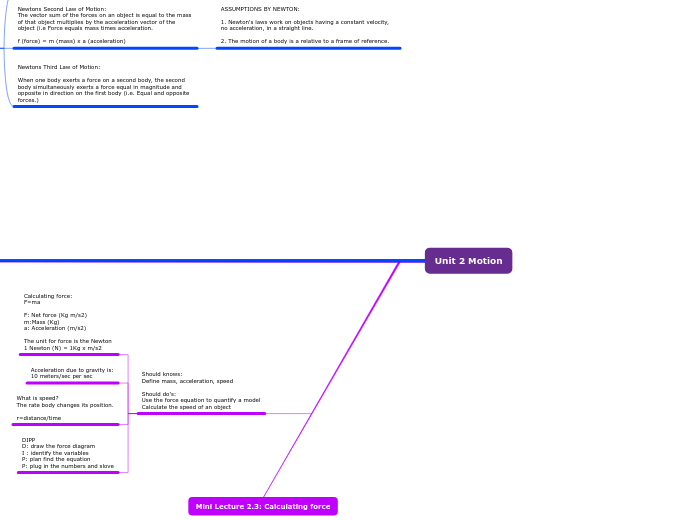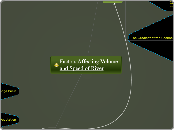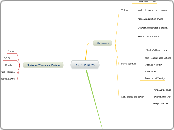Unit 2 Motion
Mini Lecture 2.4: What is friction?
Should Knows:
-Define friction, normal force
Should Do's:
-Identify variables that influence friction
-Calculate the forces required using the friction equations
Calculating force
Fnet= Fa + Ff
Revised force equation:
Fnet= m(a)
F=total force
m=mass
a= acceleration
What variables influence friction?
(independent variable)
-Normal force (mass): increase the contact force
-Surface texture: increase surface areas= contact force
-Surface area (amount
of contact)
-Motion: decreases the contact force
Mini Lecture 2.2
Should know:
Define vector, scalar, distance, displacement
Should do's:
-Explain the difference between:
vector and scalar quantities, distance and displacement
Distance Vs Displacement
Displacement:
-a vector quantity distance and direction traveled by an object
CHANGE IN MOVEMENT
Vector quantities: Displacement, Direction, Acceleration, Velocity
Distance:
-A scalar quantity
-Distance traveled by an object during its motion
Scalar quantities: Length, Area, Volume, Speed, Mass, Density
Mini Lecture 2.3: Calculating force
Should knows:
Define mass, acceleration, speed
Should do's:
Use the force equation to quantify a model
Calculate the speed of an object
DIPP
D: draw the force diagram
I : identify the variables
P: plan find the equation
P: plug in the numbers and slove
What is speed?
The rate body changes its position.
r=distance/time
Acceleration due to gravity is:
10 meters/sec per sec
Calculating force:
F=ma
F: Net force (Kg m/s2)
m:Mass (Kg)
a: Acceleration (m/s2)
The unit for force is the Newton
1 Newton (N) = 1Kg x m/s2
Mini Lecture 2.1: Describing Forces
Should know:
Define: force, normal force, contact force and non contact force.
Should Dos:
Explain the difference between contact and non contact forces
create and interpret free body diagrams
How do we describe forces?
WE USE FREE BODY DIAGRAMS
Fg : Force of the object or weight
Fn : Normal force the force perpendicular
to the surface and object is on contact with
Ff : Force of friction (small f is always friction)
Fa : applied force- the push of pull
BIG F = force
-Gravity has a negative value
-Normal force has a positive force
-Forces moving left are negative
-Forces moving right are positive
Subtopic
Are there non contact forces?
Attract or repel,
even from a distance
Example
-Magnetic force
-Electric force
-Gravitational force
What is a contact force?
Contact Force: A force that requires contact
between objects. Examples are tension, normal
force, and friction.
-Applied force
-Spring force
-Drag force
-Frictional force
-Normal force (If there is no contact
between surfaces, there is no normal force
What makes object moves?
Force: energy that changes the
motion of a body
Endothermic vs exothermic
LAw of conservation of energy:
Energy can not be crested or destroyed it can only form
Exothermic:
Energy is released into the surrounding enviorment
Endothermic:
Energy is absorbed from the surrounding enviorment
What is inertia?
What variables affect inertia?
-Friction
-Mass
The resistance to a change in motion
Mini Lecture 2.0
Should Knows
Define:
Should Do's
1. Explain Newton's Laws.
2. Identify Newton's Laws at work for various models.
3. Apply Newton's Laws to quantify an outcome for a given model.
4. Identify the limitations of Newtons Laws.
What are Newtons Three Laws?
Newtons Third Law of Motion:
When one body exerts a force on a second body, the second body simultaneously exerts a force equal in magnitude and opposite in direction on the first body (i.e. Equal and opposite forces.)
Newtons Second Law of Motion:
The vector sum of the forces on an object is equal to the mass of that object multiplies by the acceleration vector of the object (i.e Force equals mass times acceleration.
f (force) = m (mass) x a (acceleration)
ASSUMPTIONS BY NEWTON:
1. Newton's laws work on objects having a constant velocity, no acceleration, in a straight line.
2. The motion of a body is a relative to a frame of reference.
Newtons First Law of Motion:
An object either remains at rest or concintues to move at a constant to move at a constant velocity, unless acted upon by an external force. (i.e.: Objects in motion tend to stay in motion. Objects at rest tend to stay at rest.)









